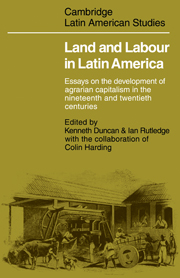 Land and Labourin Latin America
Land and Labourin Latin America Book contents
- Frontmatter
- Contents
- List of tables
- List of figures
- List of maps
- Acknowledgements
- 1 Introduction: patterns of agrarian capitalism in Latin America
- PART I THE TRANSITION FROM TRADITIONAL HACIENDA TO CAPITALIST ESTATE
- PART II THE DEVELOPMENT OF A PLANTATION ECONOMY WITH LABOUR RECRUITMENT FROM HIGHLAND PEASANT COMMUNITIES
- 8 The integration of the highland peasantry into the sugar cane economy of northern Argentina, 1930–43
- 9 The social and economic consequences of modernization in the Peruvian sugar industry, 1870–1930
- 10 The dynamics of Indian peasant society and migration to coastal plantations in central Peru
- 11 A Colombian coffee estate: Santa Bárbara, Cundinamarca, 1870–1912
- PART III THE DEVELOPMENT OF COMMERCIAL AGRICULTURE USING EUROPEAN IMMIGRANT LABOUR
- PART IV THE TRANSITION FROM SLAVE PLANTATION TO CAPITALIST PLANTATION
- PART V POSTSCRIPT
- Glossary of Spanish and Portuguese terms used in the text
- Weights and measures
- Notes on contributors
- Indexes Subjects
- Authors
11 - A Colombian coffee estate: Santa Bárbara, Cundinamarca, 1870–1912
Published online by Cambridge University Press: 07 May 2010
- Frontmatter
- Contents
- List of tables
- List of figures
- List of maps
- Acknowledgements
- 1 Introduction: patterns of agrarian capitalism in Latin America
- PART I THE TRANSITION FROM TRADITIONAL HACIENDA TO CAPITALIST ESTATE
- PART II THE DEVELOPMENT OF A PLANTATION ECONOMY WITH LABOUR RECRUITMENT FROM HIGHLAND PEASANT COMMUNITIES
- 8 The integration of the highland peasantry into the sugar cane economy of northern Argentina, 1930–43
- 9 The social and economic consequences of modernization in the Peruvian sugar industry, 1870–1930
- 10 The dynamics of Indian peasant society and migration to coastal plantations in central Peru
- 11 A Colombian coffee estate: Santa Bárbara, Cundinamarca, 1870–1912
- PART III THE DEVELOPMENT OF COMMERCIAL AGRICULTURE USING EUROPEAN IMMIGRANT LABOUR
- PART IV THE TRANSITION FROM SLAVE PLANTATION TO CAPITALIST PLANTATION
- PART V POSTSCRIPT
- Glossary of Spanish and Portuguese terms used in the text
- Weights and measures
- Notes on contributors
- Indexes Subjects
- Authors
Summary
Cundinamarca was the second region of Colombia to export coffee, following Cúcuta and other parts of Santander, which had been exporting since early in the nineteenth century. Cundinamarca was exporting noticeable amounts in the late 1860s, and came to export about 10 per cent of the nation's total just before the First World War, the proportion thereafter declining. In contrast with Caldas-Antioquia, which became and remains the leading coffee-producing area of the country, estates in Cundinamarca were large, some few having over a million trees. There were few coffee-producing homesteads or smallholdings. The potential coffee land of the department was a frontier for enterprise (and was lyrically described as such by Medardo Rivas in his Los trabajadores de la tierra caliente, first published in 1899), but it was not frontier land in the colonizing sense. Most of the land had title, and most of the titleholders were able to make it stick. Here the predominant mode of bringing afinca into production was to give it out in lots to arrendatarios, who would plant out coffee under the owner's or administrator's direction, receiving the young plants from a central nursery. The arrendatario would grow his own food crops, but not coffee, and might be moved to work on a new area of the finca when his original plants came into production. The Santander sharecropping system was not employed. This essay will examine in detail the working of a single finca, Santa Bárbara in the municipio of Sasaima, only one unit in one of the several types of society that coffee has brought into being in Colombia, but one for which a very rich documentation has survived.
- Type
- Chapter
- Information
- Land and Labourin Latin AmericaEssays on the Development of Agrarian Capitalism in the nineteenth and twentieth centuries, pp. 269 - 298Publisher: Cambridge University PressPrint publication year: 1978


